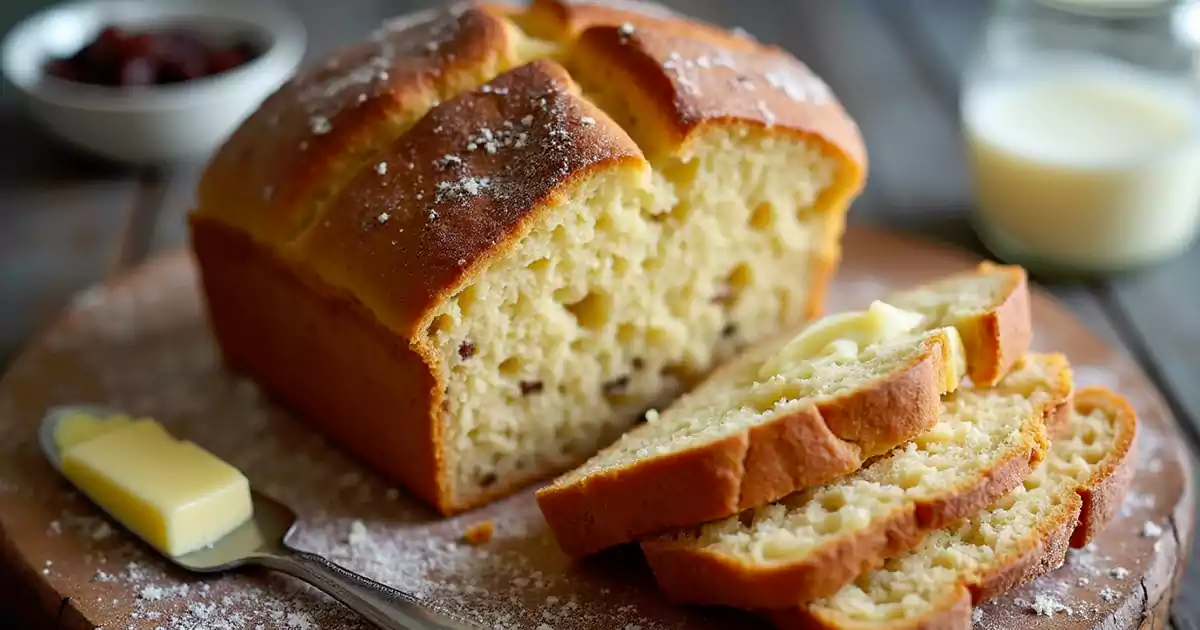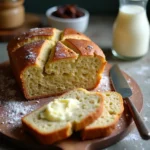If you love the hearty, rustic flavor of traditional Irish soda bread but need a gluten-free alternative, you’re in the right place. This gluten-free Irish soda bread is easy to make, deliciously soft, and perfect for enjoying with butter, jam, or a warm bowl of soup.
Traditional Irish soda bread is known for its simple ingredients and quick baking process—no yeast required. However, making it gluten-free can be tricky, as some flour blends result in a dry or crumbly texture. Don’t worry—this recipe is carefully crafted to give you a soft, flavorful loaf that’s just as satisfying as the classic version.
In this post, you’ll learn:
- A bit of history about Irish soda bread
- The best gluten-free ingredients to use
- Step-by-step instructions for baking the perfect loaf
- Tips for making it dairy-free or adding mix-ins like raisins
Let’s get started and bring a taste of Ireland to your kitchen—without the gluten.
What Is Irish Soda Bread? (A Brief History)
Irish soda bread is a traditional quick bread that has been a staple in Irish households for centuries. Unlike yeast-based breads, soda bread relies on the chemical reaction between baking soda (sodium bicarbonate) and an acidic ingredient—typically buttermilk—to create rise and structure. This unique method makes it easy to prepare, requiring no kneading, proofing, or long fermentation times, which was especially convenient for rural Irish families in the 19th century.
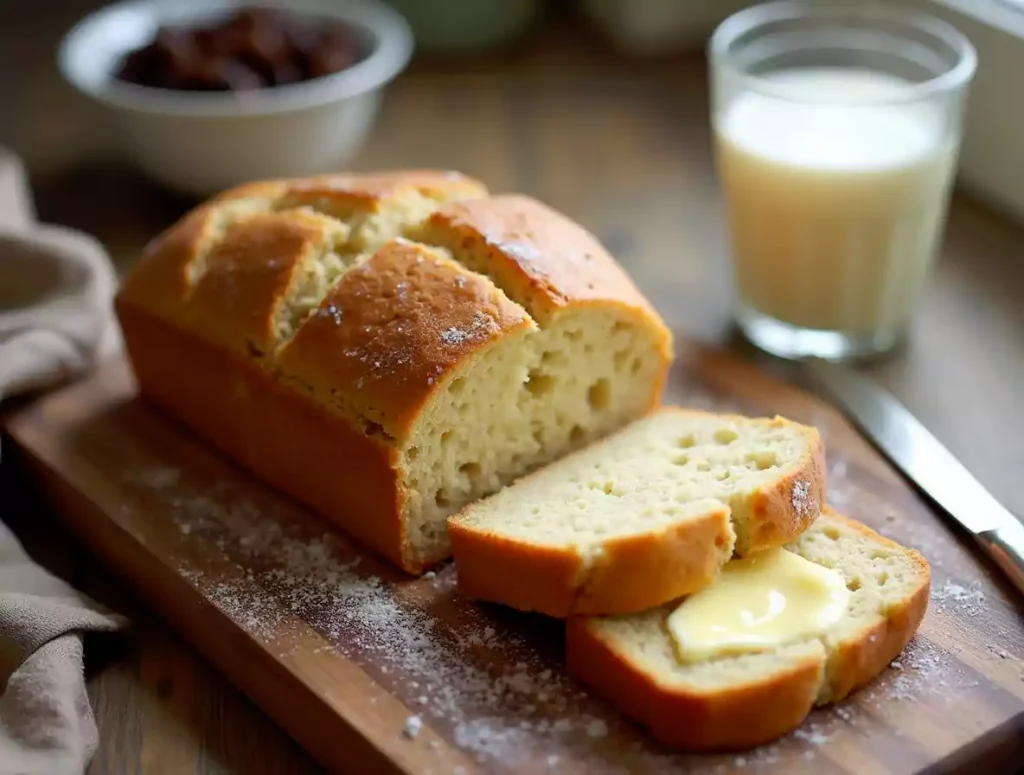
The Origins of Irish Soda Bread
The origins of soda bread in Ireland date back to the early 1800s, when baking soda became widely available as a leavening agent. Before that, most breads were made with sourdough starters or other natural fermentation techniques. However, Ireland’s soft wheat, which is lower in gluten compared to the hard wheat varieties grown in other regions, made yeast-based bread more challenging to produce. Baking soda provided the perfect solution, allowing Irish bakers to create a simple, hearty bread using just a few basic ingredients: flour, baking soda, salt, and buttermilk.
Why Was Soda Bread So Popular in Ireland?
Ireland’s economy and agriculture were largely based on small farms, where access to expensive ingredients like yeast was limited. Soda bread became a practical and affordable solution because:
- It could be made with readily available ingredients found in most Irish households.
- It was quick to prepare, making it ideal for everyday meals.
- It required no special baking equipment, just a cast-iron pot or a simple griddle.
For many Irish families, soda bread was an essential part of daily life, served with butter, jam, or soups and stews.
Traditional vs. Modern Variations
The most authentic versions of Irish soda bread are quite simple, consisting only of flour, baking soda, salt, and buttermilk. However, over time, different variations have emerged, including:
- White Soda Bread: Made with refined white flour for a softer texture.
- Brown Soda Bread: Uses wholemeal flour, giving it a denser, more rustic feel.
- Sweetened Soda Bread: Some versions include sugar, raisins, currants, or even caraway seeds for added flavor.
Today, gluten-free Irish soda bread offers a way for those with celiac disease or gluten sensitivity to enjoy this beloved classic while maintaining dietary restrictions. By swapping traditional wheat flour for a gluten-free blend, we can recreate the same hearty texture and rich flavor that has made Irish soda bread a favorite for generations.
Key Ingredients for Gluten-Free Irish Soda Bread
One of the biggest challenges in making gluten-free Irish soda bread is achieving the right texture and flavor. Traditional soda bread relies on the reaction between baking soda and buttermilk to create a light and airy structure. However, when removing gluten, we need to carefully select ingredients that mimic the elasticity and binding properties of wheat flour. Below are the key ingredients that make this gluten-free version just as delicious as the classic one.

1. Gluten-Free Flour Blend
Choosing the right gluten-free flour is crucial for getting the perfect texture. Since gluten provides elasticity and structure, a mix of gluten-free flours is needed to replicate these characteristics. Here’s what to consider when selecting or making a flour blend:
- Recommended Store-Bought Blends: Look for all-purpose gluten-free flour blends that contain a mix of rice flour, potato starch, and tapioca flour. Brands like Bob’s Red Mill, King Arthur, and Cup4Cup work well.
- Homemade Blend: If making your own, a good mix includes brown rice flour, white rice flour, tapioca starch, and sorghum flour for better texture and flavor.
- Xanthan Gum or Guar Gum: These act as a gluten substitute, helping to bind the ingredients and prevent a crumbly texture. If your flour blend does not contain xanthan gum, you’ll need to add about ½ teaspoon per cup of flour.
2. Buttermilk or Dairy-Free Alternatives
Buttermilk plays an essential role in Irish soda bread, as its acidity reacts with baking soda to create the rise. If you are dairy-free, you can still achieve this effect with the right substitutes:
- Traditional Buttermilk: Adds a slightly tangy flavor and helps activate the baking soda for leavening.
- Dairy-Free Buttermilk Substitute: Mix 1 cup of unsweetened almond milk, oat milk, or coconut milk with 1 tablespoon of vinegar or lemon juice and let it sit for 5-10 minutes to create a similar acidity level.
- Greek Yogurt or Sour Cream: Can also be used as an alternative if you prefer a denser texture.
3. Baking Soda and Salt
Since Irish soda bread is a quick bread, it does not require yeast. Instead, it depends on baking soda for leavening, which reacts with the acidity in buttermilk (or a dairy-free substitute) to create a light texture.
- Baking Soda: Be sure to use fresh baking soda for the best rise. If your soda is old, the bread may turn out dense.
- Salt: A small amount enhances the flavor and balances the sweetness if you choose to add raisins.
4. Optional Additions for Extra Flavor
While traditional Irish soda bread is made with just flour, buttermilk, baking soda, and salt, you can customize your gluten-free version with mix-ins:
- Raisins or Currants: Add sweetness and texture, making it more like the Irish “Spotted Dog” variation.
- Caraway Seeds: Give the bread a distinct, slightly anise-like flavor.
- Butter or Coconut Oil: Adds richness and moisture to prevent dryness.
- Honey or Maple Syrup: A touch of natural sweetness can enhance the overall flavor.
By choosing high-quality ingredients and making simple substitutions, you can create a gluten-free Irish soda bread that is flavorful, soft, and perfect for any occasion. Now that we’ve covered the ingredients, let’s move on to the step-by-step process of making this delicious bread.
Step-by-Step Guide to Making Gluten-Free Irish Soda Bread
Making gluten-free Irish soda bread is simple, but to achieve the right texture and flavor, it’s important to follow a few key steps. Unlike traditional bread recipes, soda bread relies on baking soda and an acidic ingredient (such as buttermilk) for leavening, meaning there’s no need for yeast or long rising times. This makes it a quick and easy option for a homemade loaf.
Below is a step-by-step guide to help you create a soft, flavorful, and gluten-free Irish soda bread.
1. Preparing Your Ingredients
Before you start mixing, gather all your ingredients and make sure they’re at room temperature. This helps the dough come together more smoothly and ensures even baking.
Here’s what you’ll need:
- Gluten-free flour blend – Choose a high-quality blend that includes xanthan gum for better structure. If your flour blend doesn’t contain xanthan gum, add about ½ teaspoon per cup of flour to prevent crumbliness.
- Baking soda – This is the key leavening agent that helps the bread rise. Make sure it’s fresh for the best results.
- Salt – A key ingredient that elevates the overall taste of bread, bringing out its rich flavors.
- Buttermilk (or dairy-free alternative) – The acidity in buttermilk reacts with the baking soda to create lift. If using a dairy-free alternative, mix one tablespoon of lemon juice or apple cider vinegar with plant-based milk and let it sit for a few minutes before adding it to the dough.
- Butter or dairy-free substitute – Adds richness and moisture to the bread.
- Optional add-ins – Traditional Irish soda bread often includes raisins, caraway seeds, or even a touch of honey for sweetness.
2. Mixing and Kneading the Dough

- In a large mixing bowl, whisk together the gluten-free flour, baking soda, and salt. This ensures even distribution of the leavening agent.
- Use a pastry cutter or your fingertips to blend the butter into the dry ingredients until the texture becomes crumbly and resembles coarse sand. This helps create a tender texture.
- Gradually add the buttermilk (or dairy-free alternative) and gently mix until a sticky dough forms. Avoid overmixing the batter, as it can result in a heavy and dense loaf. Keep the mixing light for a soft, fluffy texture.
- If adding raisins or seeds, fold them in gently at this stage.
3. Shaping and Baking the Bread
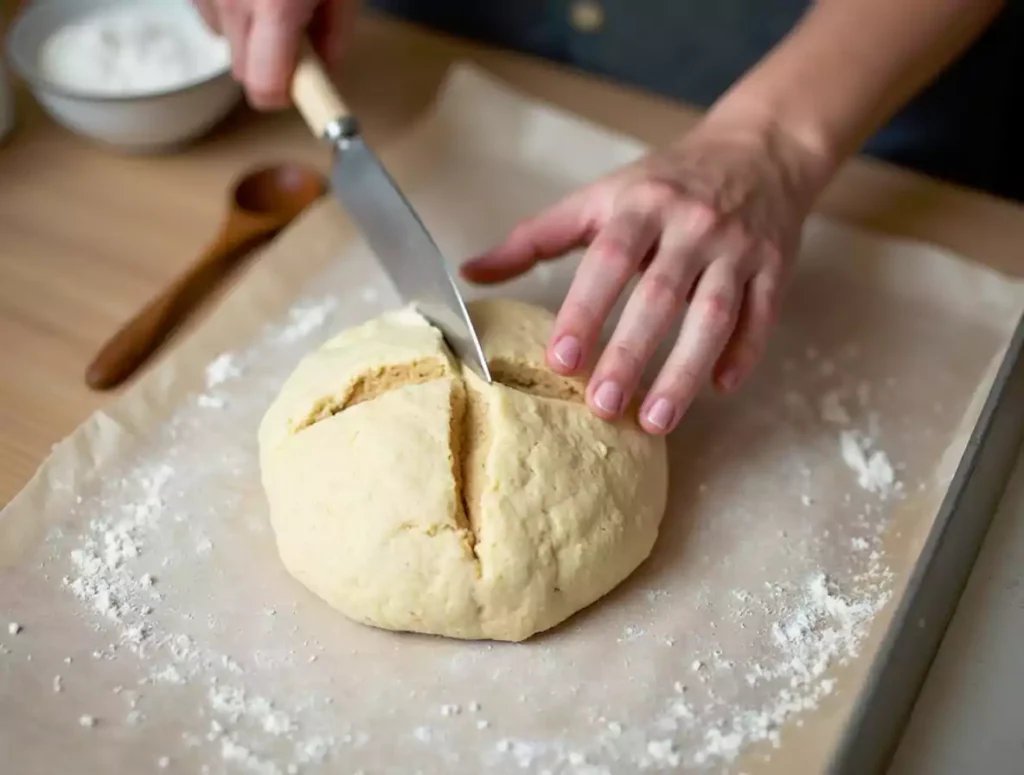
- Lightly dust a clean surface with gluten-free flour and turn out the dough. Gently shape it into a round loaf. If the dough is too sticky, sprinkle a little extra flour to make it easier to handle.
- Place the dough on a parchment-lined baking sheet.
- Using a sharp knife, score a deep “X” across the top. This helps the bread bake evenly and is also a traditional Irish baking technique believed to let the fairies out.
- Bake in a preheated oven at 375°F (190°C) for about 40-45 minutes or until the crust is golden brown and the bread sounds hollow when tapped on the bottom.
4. Cooling and Serving Tips
Leftovers can be stored at room temperature for up to two days or frozen for longer storage. To reheat, simply toast slices or warm them in the oven for a few minutes.
After baking, take the bread out of the oven and place it on a wire rack to cool for at least 30 minutes before cutting into it. This helps retain its texture and flavor. This helps the texture set properly.
Serve warm with butter, jam, or alongside soups and stews.
Tips for the Best Gluten-Free Irish Soda Bread
Making a great loaf of gluten-free Irish soda bread requires a few key techniques to ensure the right texture, taste, and structure. Since gluten-free baking can be a bit unpredictable, following these tips will help you achieve a soft, flavorful, and well-risen loaf every time.
1. Avoid Overmixing the Dough
One of the biggest mistakes in baking gluten-free bread is overmixing. Unlike traditional doughs that rely on gluten for elasticity, gluten-free doughs are more delicate. Overworking the mixture can lead to a dense and tough texture instead of the soft, crumbly consistency that makes Irish soda bread so enjoyable.
- Mix just until all the ingredients are combined.
- The dough will be slightly sticky and shaggy, which is normal.
- Avoid kneading—simply shape it gently into a round loaf.
2. Choose the Right Gluten-Free Flour Blend
Not all gluten-free flour blends work the same way. Some absorb more moisture, while others may lack the binding power needed for structure. A high-quality gluten-free all-purpose flour with xanthan gum or another binding agent is essential.
- Look for blends that contain a mix of rice flour, tapioca starch, and potato starch for better texture.
- If your blend doesn’t contain xanthan gum or guar gum, add ½ teaspoon per cup of flour to improve elasticity.
- Avoid single-flour options like almond or coconut flour alone, as they behave very differently.
3. Make It Dairy-Free (If Needed)
Traditional Irish soda bread is made with buttermilk, which helps create its signature tangy flavor and tender crumb. If you’re avoiding dairy, you can easily substitute it while maintaining the same results.
- Use unsweetened almond milk, oat milk, or coconut milk as a base.
- Add 1 tablespoon of apple cider vinegar or lemon juice to the milk substitute to mimic the acidity of buttermilk.
- Use dairy-free butter or coconut oil in place of regular butter.
4. Shape and Score the Dough Properly
Since gluten-free dough is more delicate than wheat-based dough, shaping and scoring it correctly can make a big difference.
- Gently form the dough into a round shape without compacting it too much.
- Place it on a parchment-lined baking sheet rather than a loaf pan to allow for even baking.
- Use a sharp knife to cut a deep “X” on top of the dough before baking. This isn’t just for tradition—it helps the bread expand and bake evenly.
5. Bake at the Right Temperature and Monitor Timing
Gluten-free breads tend to take a bit longer to bake than their traditional counterparts. A properly baked loaf should be golden brown on the outside and cooked through in the center.
- Bake at 375°F (190°C) for about 40–50 minutes.
- Check for doneness by inserting a toothpick or skewer in the center—it should come out clean.
- If the top is browning too quickly, loosely cover it with foil for the last 10–15 minutes of baking.
6. Storage and Freezing Tips
Since gluten-free bread lacks the same moisture-retaining properties as wheat-based bread, it can dry out quickly. Here’s how to keep it fresh for longer:
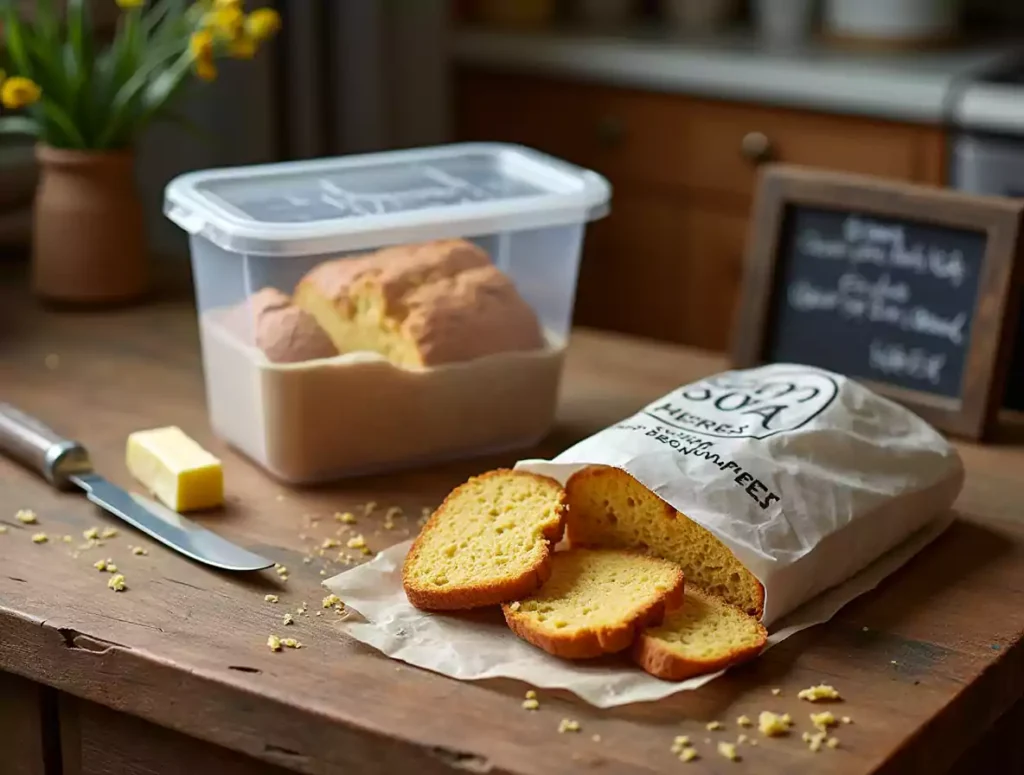
- Wrap leftovers tightly in plastic wrap or store in an airtight container at room temperature for up to two days.
- For longer storage, slice and freeze the bread. Place slices in a zip-top bag with parchment between them to prevent sticking.
- To enjoy frozen slices, toast them directly or warm in the oven at 300°F (150°C) for a few minutes.
By following these tips, you’ll be able to make a perfectly textured, flavorful, and satisfying gluten-free Irish soda bread every time. Whether you enjoy it fresh out of the oven, toasted with butter, or alongside a hearty bowl of soup, this bread is a must-try for anyone looking for a gluten-free twist on a classic recipe.
Frequently Asked Questions
Can I Make This Bread Without Xanthan Gum?
Yes, but you’ll need a substitute to help bind the dough. Try:
Guar gum – Another good alternative
Psyllium husk powder – Helps with texture
Ground flaxseed or chia seed – Mix with water to create a gel
What’s the Best Gluten-Free Flour for Soda Bread?
Use a gluten-free all-purpose flour blend that contains rice flour, potato starch, and tapioca starch. If making your own blend, try:
- 1 ½ cups rice flour
- ½ cup potato starch
- ¼ cup tapioca starch
- 1 teaspoon xanthan gum (if using)
Avoid using only almond or coconut flour, as the
How Do I Make a Vegan Version?
Replace dairy ingredients with these:
Butter substitute – Use dairy-free butter or coconut oil
Buttermilk substitute – Mix 1 cup of almond, oat, or soy milk with 1 tablespoon of lemon juice or apple cider vinegar
Conclusion
Gluten-free Irish soda bread is a delicious and easy way to enjoy a classic Irish recipe without the gluten. With the right ingredients and techniques, you can create a loaf that is soft, flavorful, and perfect for any occasion.
By following the tips in this guide—using a good gluten-free flour blend, avoiding overmixing, and properly shaping the dough—you’ll be able to bake a successful loaf every time. Whether you enjoy it fresh with butter, alongside a hearty soup, or toasted for breakfast, this bread is a wonderful addition to any gluten-free kitchen.
Now it’s your turn to try this recipe! Let us know how it turned out in the comments, and feel free to share any variations or tips you discovered along the way. Happy baking!
Try out this Irish Soda Bread and let your creativity shine! We’d love to see your sweet creations. Tag us on Instagram at @SweetEatsRecipes and use the hashtag #IrishSodaBread to get featured.
Gluten-Free Irish Soda Bread
Equipment
- Mixing Bowl
- Whisk
- Wooden spoon
- Baking sheet
- Sharp knife
Ingredients
- 2 ½ cups Gluten-free all-purpose flour
- 1 tsp Baking soda
- ½ tsp Salt
- 1 ¼ cups Buttermilk
- 2 tbsp Butter
- 1 tbsp Honey
- ½ cup Raisins
Instructions
- Preheat the oven to 375°F (190°C). Line a baking sheet with parchment paper.
- Mix the dry ingredients – In a large bowl, whisk together gluten-free flour, baking soda, and salt.
- Add wet ingredients – Pour in the buttermilk and melted butter, stirring until a sticky dough forms.
- Shape the dough – Lightly flour your hands and shape the dough into a round loaf. Place it on the prepared baking sheet.
- Score the top – Using a sharp knife, cut an "X" on top of the dough to help it bake evenly.
- Bake – Place in the oven and bake for 40–50 minutes until golden brown.
- Cool and serve – Let the bread rest for 10 minutes before slicing. Enjoy warm with butter or jam.
Notes
- If your gluten-free flour does not contain xanthan gum, add ½ teaspoon for better texture.
- For a dairy-free version, use almond or oat milk with lemon juice instead of buttermilk.
- This bread is best enjoyed fresh but can be stored for 2 days at room temperature or frozen for up to a month.

